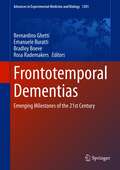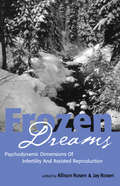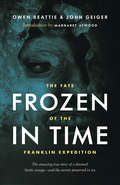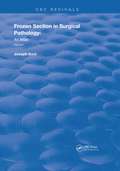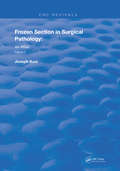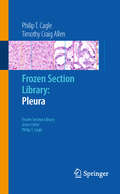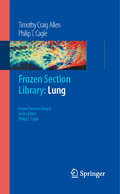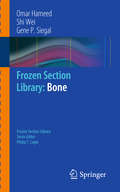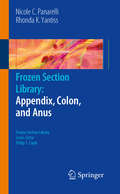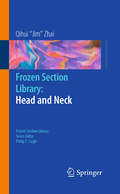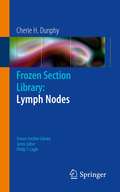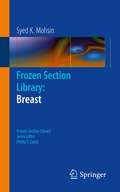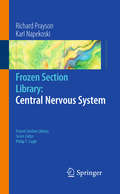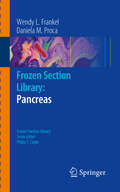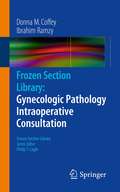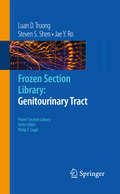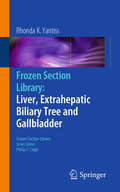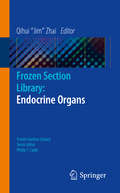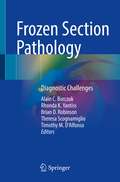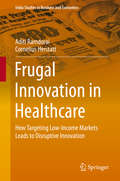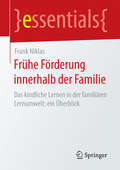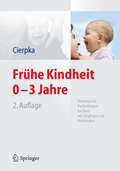- Table View
- List View
Frontoffice en administratie voor tandartsassistenten (Basiswerk AG)
by Maria de Vries Elly HogeveenDit studieboek is bedoeld voor studenten van de mbo-opleiding tandartsassistent. De theorie en verwerkingsopdrachten helpen je bij de communicatie met patiënten en een goede tandheelkundige administratie te voeren, zowel in de frontoffice, backoffice als aan de behandelstoel. Het leert je hoe je een patiëntenadministratie voert en hoe je declaraties correct afhandelt. Daarbij is inzicht en kennis van wet- en regelgeving noodzakelijk. Het studieboek is bedoeld voor assistenten in opleiding, maar is ook geschikt als naslagwerk voor medewerkers in de mondzorgpraktijk.Deze vierde druk is geactualiseerd na de invoering van het nieuwe kwalificatiedossier. Het boek is uitgebreid met nog meer kennis en vaardigheden. De theorie is waar mogelijk zo veel mogelijk versimpeld en er zijn nieuwe afbeeldingen toegevoegd. Er staan veel verwerkingsopdrachten in om zelf te kunnen oefenen met de lesstof. Ten slotte is het laatste hoofdstuk over beheertaken uit dit boek verwijderd. Het boek Management, beheer en organisatie voor tandartsassistenten voorziet in de behoefte aan meer uitleg en informatie over dit thema en veel meer. Elly Hogeveen is van oorsprong tandarts- en preventieassistent en is docent aan de opleiding tot tandartsassistent aan ROC Friese Poort in Leeuwarden. Ook is zij praktijkmanager in een tandartsenpraktijk te Grou. Maria de Vries is begonnen als tandartsassistent en is docent aan de opleiding tot tandartsassistent aan de Noorderpoort in Groningen. Tevens is zij praktijkmanager in een tandartsenpraktijk te Burgum. Beiden verzorgen een breed scala aan lessen over administratie, management, beheer & organisatie, praktijkvoering en omgangskunde.
Frontotemporal Dementias: Emerging Milestones of the 21st Century (Advances in Experimental Medicine and Biology #1281)
by Bernardino Ghetti Emanuele Buratti Bradley Boeve Rosa RademakersUnder the name of Frontotemporal Dementias (FTD) numerous hereditary and sporadic disorders are listed. FTD may take away speech and language, social skills and ethical judgement, wishes and will, empathy and emotions; it may also impair motor functions. FTD may affect men and women in midlife or during old age leading to the demolition of the uniqueness of the human mind. In the last decade of the 20th century and in the first two decades of the 21st century, progress in the understanding of clinical, neuropathological, biochemical, and genetic aspects of FTD has accelerated. The novel awareness about FTD has directed young generations of researchers toward the study of this complex group of disorders. This Volume has been formulated with the participation of some of the leading scientists who have contributed to the development of knowledge in the clinical and basic science arenas. It captures the current central elements that are relevant to an up-to-date understanding of causes and pathogenesis of multiple forms of FTD. The volume is an opus that represents a distillation of the work of many scientists and addresses the current directions in the study of one of the most complex groups of diseases. In view of its structure, the book could also be used as a textbook, that offers both a broad and deep analysis of major areas in FTD. This book, planned by the International Society for Frontotemporal Dementias, is distinctive as it opens a window to a wide landscape about the biology of FTD. Thus, the book represents a moment of reflection on the present state of our knowledge of FTD and a collective vision toward scientific progress. The authors of each chapter share their knowledge and vision aimed at reducing the suffering which is caused by FTD.
Frozen Dreams: Psychodynamic Dimensions of Infertility and Assisted Reproduction
by Jay Rosen Allison RosenWedding up-to-date scientific information to an understanding of the emotional burdens and ethical dilemmas that inhere in reproductive medicine, Frozen Dreams: Psychodynamic Dimensions of Infertility and Assisted Reproduction provides an overview of the psychology of infertility patients and of the evaluative, administrative, and especially psychotherapeutic issues involved in helping them. The contributors to this volume, who include professionals from nationally prestigious reproductive programs as well as psychotherapists who evaluate and work clinically with infertility patients, explore the complex choices about life and death that are the daily experience of infertility specialists. In voices equally authoritative and intimate, psychotherapists and other health professionals explore the therapeutic process with patients and couples struggling with miscarriage, infertility, childlessness, the possibility of adoption, and the promise of assisted pregnancy. And the contributors are equally attentive to the range of issues that challenge physicians and nurses active in reproductive medicine, intent on providing practical information that will aid decision-making in this demanding area of practice. Written for a large audience of psychiatrists, psychologists, social workers, researchers, nurses, physicians, and general readers, Frozen Dreams is a fascinating introduction to the human face of reproductive medicine. Filled with intriguing and edifying case histories, it will appeal to all mental health professionals who work with adult patients through their childbearing years. For professionals who work inside the complex world of infertility treatment, Frozen Dreams will quickly become an essential text that is turned to repeatedly for information, guidance, reassurance, and revitalization.
Frozen in Time
by Owen Beattie John GeigerThe Franklin expedition was not alone in suffering early and unexplained deaths. Indeed, both Back (1837) and Ross (1849) suffered early onset of unaccountable "debility" aboard ship and Ross suffered greater fatalities during his single winter in the Arctic than did Franklin during his first. Both expeditions were forced to retreat because of the rapacious illness that stalked their ships. Frozen in Time makes the case that this illness (starting with the Back expedition) was due to the crews' overwhelming reliance on a new technology, namely tinned foods. This not only exposed the seamen to lead, an insidious poison - as has been demonstrated in Franklin's case by Dr. Beattie's research - but it also left them vulnerable to scurvy, the ancient scourge of seafarers which had been thought to have been largely cured in the early years of the nineteenth century. Fully revised, Frozen in Time will update the research outlined in the original edition, and will introduce independent confirmation of Dr. Beattie's lead hypothesis, along with corroboration of his discovery of physical evidence for both scurvy and cannibalism. In addition, the book includes a new introduction written by Margaret Atwood, who has long been fascinated by the role of the Franklin Expedition in Canada's literary conscience, and has made a pilgrimage to the site of the Franklin Expedition graves on Beechey Island.
Frozen in Time
by John Geiger Margaret Atwood Owen BeattieThe truth about what happened on Sir John Franklin's ill-fated Arctic expedition of 1845-48 has been shrouded in mystery for 165 years. Carrying the best equipment that the science and technology, Franklin and his men set out to "penetrate the icy fastness of the north, and to circumnavigate America." The expedition's two ships - HMS Erebus and HMS Terror - carrying 129 officers and men, disappeared without a trace. From 1846 to 1880 more than 20 major rescue parties were involved in the search for the missing men and ships. The disappearance of the expedition and absence of any substantial written accounts of the journey have left attempts at a reconstruction of events sketchy and inconclusive. In Frozen in Time, forensic anthropologist Owen Beattie and historian John Geiger tell the dramatic story of the excavation of three sailors from the Franklin Expeditions, buried for 138 years on the lonely headland of Beechey Island. This book contains the astonishing photographic record of the excavation, together with the maps and illustrations that accompany this riveting account of Franklin's fatal adventure. The unfolding of Dr. Beattie's unexpected findings is not only a significant document but also, in itself, a tale of high adventure.
Frozen Section in Surgical Pathology: An Atlas Volume 1 (Routledge Revivals)
by Joseph KoviPublished in 1983: In this Atlas the discussion of equipment, technique, its nuances, and problems is followed by clinical and pathological presentations.
Frozen Section In Surgical Pathology: An Atlas Volume 2 (Routledge Revivals)
by Joseph KoviPublished in 1983: In this Atlas the discussion of equipment, technique, its nuances, and problems is followed by clinical and pathological presentations.
Frozen Section Library: Pleura
by Timothy Craig Allen Philip T. CagleFrozen sections are diagnosed by the pathologist while a patient is undergoing surgery, often under general anesthesia, for the purpose of rapid diagnosis which may be used to make immediate treatment decisions or to confirm that diagnostic tissues have been sampled for further study. As a result, frozen section diagnosis is often a highly demanding situation for the pathologist who must render a diagnosis quickly and is a basis for critical decisions to the surgeon. In addition to the need for rapid recall of differential diagnoses, there are many pitfalls and artifacts that add to the risk of frozen section diagnosis that are not present with permanent sections of fully processed tissues that can be examined in a more leisurely fashion. Most standard pathology textbooks, both general and subspecialty, largely ignore the topic of frozen section. Few textbooks have ever focused exclusively on frozen section diagnosis and those textbooks that have done so are now out-of-date and have limited numbers of black and white figures. Frozen Section Library: Pleura provides a convenient, user-friendly handbook to expedite use when performing intraoperative consultations on pleural specimens. This book is divided into chapters that emphasize the common questions that a pathologist must answer on frozen section examination and the pitfalls associated with those specific diagnoses. The diagnostic issues impacting immediate surgical decision-making are color illustrated and discussed succinctly, including a complex array of primary and secondary neoplasms of the pleura that have overlapping histologic features and the well-known problems of reactive atypia versus cancer in pleural tissue. As a handbook for practicing pathologists, this book is an indispensable aid to diagnosis and avoiding dangers in one of the most challenging situations that pathologists encounter. Rapid consideration of differential diagnoses and how to avoid traps caused by frozen section artifacts will be readily accessible to the users of this handbook. Tables provide guidance for various categories of differential diagnoses. Currently, there is no other up-to-date single-source reference specifically focused on frozen sections of the pleura. This book will be highly valuable to practicing surgical pathologists, both community and academic, and to pathology residents and fellows. The perspectives provided will also be valuable to thoracic surgeons and especially to surgery residents and thoracic surgery fellows who must answer questions about pathology and frozen section on their board examinations.
Frozen Section Library: Lung
by Philip T. Cagle Timothy Craig AllenFrozen sections are performed for the purpose of rapid diagnosis while a patient is undergoing surgery, usually under general anesthesia, as a basis for making immediate treatment decisions. Therefore, frozen section diagnosis is often a highly demanding situation for the pathologist who must render a diagnosis quickly and a crucial determination for the patient and surgeon. In addition to the need for rapid recall of differential diagnoses, there are many pitfalls and artifacts that add to the risk of frozen section diagnosis that are not present with permanent sections of fully processed tissues that can be examined in a more leisurely fashion. Most standard pathology textbooks, both general and subspecialty, largely ignore the topic of frozen section. Few textbooks have ever focused exclusively on frozen section diagnosis and those textbooks that have done so are now out-of-date and have limited numbers of black and white figures. None has emphasized the education of the surgeon in terms of frozen section benefits, limitations or proper utilization. The Frozen Section Library series will provide convenient, user-friendly handbooks for each organ system to expedite use in the hurried frozen section situation. These books will be small and light-weight, copiously color illustrated with images of actual frozen sections, highlighting pitfalls, artifacts and differential diagnosis. These books will also include perspectives for the surgeon and for communication with the surgeon and suggest ancillary procedures (for example, when to take tissue for microbiology cultures). Each 5 X 8 book is estimated to be about 200 to 250 pages in toto with 100 to 150 color figures each. As a handbook for practicing pathologists, these books will be indispensable aids to diagnosis and avoiding dangers in one of the most challenging situations that pathologists encounter. Problems, such as differentiation of benign processes from malignant neoplasms which may be more difficult on frozen section than permanent section and which have a serious impact on the surgeon's immediate treatment decisions, will be emphasized. Rapid consideration of differential diagnoses and how to avoid traps caused by frozen section artifacts will be readily accessible to the users of the handbooks. A series of concise, easy-to-use, well-illustrated handbooks alleviates the often frustrating and time-consuming, sometimes futile, process of searching through bulky textbooks that are unlikely to illustrate or discuss pathologic diagnoses from the perspective of frozen sections in the first place. Tables and charts will provide guidance for differential diagnosis of various histologic patterns. The advantages of a series of organ-specific handbooks, in addition to the ease-of-use and manageable size, is that (1) it allows more comprehensive coverage of more diagnoses, both common and rare, than a single volume that tries to highlight a limited number of diagnoses for each organ and (2) it allows more detailed insight by permitting experienced authorities to emphasize the peculiarities of frozen section for each organ system. Although some differences in practice of frozen section exist between different institutions, such as differing policies regarding whether or not to perform frozen section on specific types of specimens, these differences are generally not significant and can be discussed ( an organ-specific handbook by an expert in that organ system permits more opportunity for this type of discussion). Touch preparations, which are used for some organs such as central nervous system or thyroid more often than others, will be appropriately emphasized and illustrated according to the need for each specific organ. This series will be highly valuable to practicing surgical pathologists, both community and academic, and to pathology residents and fellows. The perspectives provided will also be valuable to surgeons and especially to surgery residents and fellows who must answer questions about pathology and frozen section on their board examinations. T...
Frozen Section Library: Bone
by Philip T. Cagle Omar Hameed Gene P. Siegal Shi WeiFrozen sections are performed while a patient is undergoing surgery as a basis for making an immediate diagnosis that will impact treatment decisions. Frozen section diagnosis is often a highly demanding situation for the pathologist who must render a diagnosis quickly for the patient and surgeon. The Frozen Section Library series will provide concise, user-friendly, site specific handbooks that are well illustrated and highlight the pitfalls, artifacts and differential diagnosis issues that arise in the hurried frozen section scenario.
Frozen Section Library: Appendix, Colon, and Anus
by Philip T. Cagle Rhonda K. Yantiss Nicole C. PanarelliAs a handbook for practicing pathologists, this book will be an indispensable aid to diagnosis and avoiding dangers in one of the most challenging situations that pathologists encounter. Rapid consideration of differential diagnoses and how to avoid traps caused by frozen section artifacts will be readily accessible to the users of this handbook. Currently, there is no other up-to-date single-source reference specifically focused on frozen sections of the lower gastrointestinal tract.
Frozen Section Library: Head and Neck
by Philip T. Cagle Qihui Jim ZhaiIntraoperative frozen section interpretation is the base for treatment for the patient within the operating room. It requires immediate answer for the surgeon's specific question and the subsequent consequences are frequently irreversible. The pathologist should be very familiar with the related differential diagnosis of the involved organ. Additionally, the pathologist needs to know many pitfalls and freezing artifacts in each organ and the clinical implications each diagnosis may result in. Frozen Section Library: Head and Neck will provide a convenient, user-friendly handbook to expedite use when performing intraoperative consultations on head and neck specimens. This book will be 5 X 8 and is estimated to be about 200 to 250 pages in toto with 100 to 150 color figures. An organ and clinical scenario based approach will be used in this book. This book will be divided into chapters based on the organs and anatomic locations. Within the chapter, a consistent format with the critical issues as a focus will be used including the frequently encountered clinical scenarios and the specific questions from the surgeons, frequent diagnostic considerations and their major diagnostic criteria with associated diagnostic pearls, artifacts and pitfalls and how to avoid them. Common and practical problems including reactive atypia versus carcinoma in salivary glands, resection margins in tongue and laryngectomy specimens, small blue cell tumors in the base of the skull, a primary lesion versus a metastatic squamous carcinoma in the neck, etc. will be illustrated with color pictures and accompanied legend. As a handbook for practicing pathologists, this book will be an indispensable aid to diagnosis and avoiding dangers in one of the most challenging situations that pathologists encounter. Rapid consideration of differential diagnoses and how to avoid traps caused by frozen section artifacts will be readily accessible to the users of this handbook. Tables and charts will provide guidance for differential diagnosis of various histological patterns. This book will be highly valuable to practicing surgical pathologists, both community and academic, and to pathology residents and fellows. The perspectives provided will also be valuable to head and neck surgeons and especially to surgery residents and head and neck surgery fellows who must answer questions about pathology and frozen section on their board examinations. This handbook will be easily portable by the individual but it is envisioned that many departments will want to also keep copies readily available in the frozen section laboratory.
Frozen Section Library: Lymph Nodes
by Cherie H. DunphyThe Frozen Section Library series provides concise, user-friendly, site specific handbooks that are well illustrated and highlight the pitfalls, artifacts and differential diagnosis issues that arise in the hurried frozen section scenario. Frozen Section Library: Lymph Nodes highlights the usefulness of techniques such as touch preparation cytology and fine needle aspiration (FNA) cytology, as well as FNA biopsy. This fascicle also suggests proper handling for subsequent ancillary studies, including flow cytometric, cytogenetic, and molecular studies. Special emphasis is given to the limitations of frozen section diagnosis in lymph node pathology. All chapters are written by experts in their fields and include the most up to date scientific information. This book serves as a very useful resource for physicians in the frozen section room and in intra-operative consultation situations dealing with, and interested in, this very complex field of diagnostic pathology. Frozen Section Library: Lymph Nodes is of great value to pathologists, residents, and fellows who diagnose pathologic processes involving lymph nodes. Cherie H. Dunphy, M.D. is Professor of Pathology and Laboratory Medicine, Executive Director of Hematopathology and Hematopathology Fellowship Department of Pathology and Laboratory Medicine University of North Carolina Chapel Hill, NC.
Frozen Section Library: Breast
by Syed K. MohsinThe Frozen Section Library series provides concise, user-friendly, site specific handbooks that are well illustrated and highlight the pitfalls, artifacts and differential diagnosis issues that arise in the hurried frozen section scenario. Frozen Section Library: Breast provides an easy reference and pocket book about the nuances of adequately handling breast specimens in a fashion that meets the increasingly complex environment of breast pathology. The pros and cons of frozen section versus use of touch imprint as well as related quality assurance requirements are addressed. Other less common uses of intraoperative evaluation, such as diagnosis and margin evaluation are described. The volume includes recommended guidelines for evaluation and documentation of specific gross pathologic features, in conjunction with radiological imaging. Techniques and protocols for such examinations are illustrated. The volume closes with an overview of the newly published guidelines for handling a variety of breast specimens, which are intended to be used for assessment of predictive factors. Syed K. Mohsin, M.D. is the Head of Breast Pathology and Medical Director, Immunohistochemistry, Riverside Methodist Hospital, Columbus, OH
Frozen Section Library: Central Nervous System
by Richard A. Prayson Philip T. Cagle Karl M. NapekoskiFrozen section of Neuropathology-related cases is performed while the patient is undergoing surgery. Intraoperative consultation is used to help guide intraoperative management of the case and to ensure that adequate and appropriate tissue has been obtained for purposes of making an accurate final diagnosis. Frozen section diagnosis is often a highly demanding situation for the pathologist, who must render a diagnosis quickly and provide sound guidance and advice. In addition to the need for rapid recall of differential diagnoses, there are many pitfalls and artifacts that add to the risk of frozen section diagnosis that are not present with permanent sections of fully processed tissue that can be examined in a more leisurely fashion. Most standard pathology textbooks focus primarily on permanent section material and largely ignore the topic of frozen section. The purpose of this volume is to add to the Frozen Section Library series and provide a convenient, user friendly handbook to assist in the evaluation of central nervous system related frozen sections. It provides a useful reference, organized around differential diagnoses, primarily by location in the central nervous system. The text will be illustrated with color pictures and include tables as appropriate. This text provides a valuable tool for the practicing surgical pathologist both in community and in academic centers as well as pathology residents and fellows in training when confronted with Neuropathology frozen section.
Frozen Section Library: Pancreas
by Daniela M. Proca Wendy L. Frankel Philip T. CagleFrozen sections of the pancreas are performed to assess resectability, for tissue confirmation and to assess margins. The clinical implications of an accurate frozen section diagnosis are dramatic as far as type and extent of surgery performed. "Frozen Section of the Pancreas" will provide a concise pictorial compendium to facilitate intraoperative consultations on pancreas specimens. The book will be 5x8 and is estimated to be 200-250 pages with 100-150 color figures. This user-friendly handbook will be divided into chapters that emphasize the common questions a pathologist must answer on frozen section examination and will provide guidance for the differential diagnosis of various histologic patterns. The purpose of this book is to aid in the timely frozen section diagnosis of pancreatic lesions by using a broad array of illustrations, which would reinforce one's visual memory, and a condensed text, useful for rapid review of main diagnostic features. Currently, there is no other up-to-date, single-source reference specifically focused on frozen sections of the pancreas.
Frozen Section Library: Gynecologic Pathology Intraoperative Consultation
by Ibrahim Ramzy Donna M. CoffeyFrozen sections are performed while a patient is undergoing surgery as a basis for making an immediate diagnosis that will impact treatment decisions. Frozen section diagnosis is often a highly demanding situation for the pathologist who must render a diagnosis quickly, based on careful gross examination of specimens to select optimal areas for microscopic examination. The Frozen Section Library series will provide concise, user-friendly, site specific handbooks that are well illustrated and highlight the pitfalls, artifacts and differential diagnosis issues that arise in the hurried frozen section scenario. Donna M. Coffey, M.D., is Assistant Professor, Department of Pathology and Laboratory Medicine, The Methodist Hospital, Houston, Texas and Weill Medical College of Cornell University, New York, New York. Ibrahim Ramzy, M.D., is Professor of Pathology - Laboratory Medicine & Obstetrics-Gynecology, University of California, Irvine, California and Adjunct Professor of Pathology, Baylor College of Medicine, Houston, Texas.
Frozen Section Library: Genitourinary Tract
by Jae Y. Ro Philip T. Cagle Luan D. Truong Steven S. ShenFrozen sections are performed for the purpose of rapid diagnosis while a patient is undergoing surgery, usually under general anesthesia, as a basis for making immediate treatment decisions. Therefore, frozen section diagnosis is often a highly demanding situation for the pathologist who must render a diagnosis quickly and a crucial determination for the patient and surgeon. In addition to the need for rapid recall of differential diagnoses, there are many pitfalls and artifacts that add to the risk of frozen section diagnosis that are not present with permanent sections of fully processed tissues that can be examined in a more leisurely fashion. Most standard pathology textbooks, both general and subspecialty, largely ignore the topic of frozen section. Few textbooks have ever focused exclusively on frozen section diagnosis and those textbooks that have done so are now out-of-date and have limited numbers of black and white figures. None has emphasized the education of the surgeon in terms of frozen section benefits, limitations or proper utilization. The Frozen Section Library series will provide convenient, user-friendly handbooks for each organ system to expedite use in the hurried frozen section situation. These books will be small and light-weight, copiously color illustrated with images of actual frozen sections, highlighting pitfalls, artifacts and differential diagnosis. These books will also include perspectives for the surgeon and for communication with the surgeon and suggest ancillary procedures (for example, when to take tissue for microbiology cultures). Each 5 X 8 book is estimated to be about 200 to 250 pages in toto with 100 to 150 color figures each. As a handbook for practicing pathologists, these books will be indispensable aids to diagnosis and avoiding dangers in one of the most challenging situations that pathologists encounter. Problems, such as differentiation of benign processes from malignant neoplasms which may be more difficult on frozen section than permanent section and which have a serious impact on the surgeon's immediate treatment decisions, will be emphasized. Rapid consideration of differential diagnoses and how to avoid traps caused by frozen section artifacts will be readily accessible to the users of the handbooks. A series of concise, easy-to-use, well-illustrated handbooks alleviates the often frustrating and time-consuming, sometimes futile, process of searching through bulky textbooks that are unlikely to illustrate or discuss pathologic diagnoses from the perspective of frozen sections in the first place. Tables and charts will provide guidance for differential diagnosis of various histologic patterns. The advantages of a series of organ-specific handbooks, in addition to the ease-of-use and manageable size, is that (1) it allows more comprehensive coverage of more diagnoses, both common and rare, than a single volume that tries to highlight a limited number of diagnoses for each organ and (2) it allows more detailed insight by permitting experienced authorities to emphasize the peculiarities of frozen section for each organ system. Although some differences in practice of frozen section exist between different institutions, such as differing policies regarding whether or not to perform frozen section on specific types of specimens, these differences are generally not significant and can be discussed ( an organ-specific handbook by an expert in that organ system permits more opportunity for this type of discussion). Touch preparations, which are used for some organs such as central nervous system or thyroid more often than others, will be appropriately emphasized and illustrated according to the need for each specific organ. This series will be highly valuable to practicing surgical pathologists, both community and academic, and to pathology residents and fellows. The perspectives provided will also be valuable to surgeons and especially to surgery residents and fellows who must answer questions about pathology and frozen section on their board examinations....
Frozen Section Library: Liver, Extrahepatic Biliary Tree and Gallbladder
by Rhonda K. YantissThe Frozen Section Library series provides concise, user-friendly, site specific handbooks that are well illustrated and highlight the pitfalls, artifacts and differential diagnosis issues that arise in the hurried frozen section scenario. Frozen Section Library: Liver, Extrahepatic Biliary Tree and Gallbladder provides a convenient reference for use during intraoperative consultation. The volume addresses commonly encountered challenges, such as the diagnosis of primary and secondary hepatic neoplasms and assessment of gross abnormalities of the gallbladder. The assessment of frozen section biopsies for liver transplantation, a challenging and increasingly encountered situation, is detailed in the form of histologic criteria that should be reported. Emphasis is placed on the differential diagnoses of gross and microscopic findings with attention to potential pitfalls and artifacts encountered on frozen section. gross and microscopic images are provided as well as user-friendly tables for quick reference.
Frozen Section Library: Endocrine Organs
by Qihui Jim" ZhaiThe Frozen Section Library series provides concise, user-friendly, site specific handbooks that are well illustrated and highlight the pitfalls, artifacts and differential diagnosis issues that arise in the hurried frozen section scenario. Written by expert surgical pathologists, Frozen Section Library: Endocrine Organs presents common and practical problems including follicular adenoma versus follicular carcinoma, papillary thyroid carcinoma versus reactive change and freezing artifact, follicular variant of papillary thyroid carcinoma, and medullary thyroid carcinoma. Anaplastic carcinoma, thyroid lymphoma, resection margin of a pancreatic endocrine tumor, pheochromocytoma within an adrenal gland and extra- adrenal gland, parathyroid tissue versus a thyroid tissue and versus a lymph node are also explored in detail. All chapters are illustrated with color pictures and accompanied legends. As a handbook for practicing pathologists, this volume is an indispensable aid to diagnosis and for avoiding dangers in one of the most challenging situations that pathologists encounter. Rapid consideration of differential diagnoses and how to avoid traps caused by frozen section artifacts are readily accessible. Tables and charts provide guidance for differential diagnosis of various histological patterns. Frozen Section Library: Endocrine Organs is a highly valuable guide for practicing surgical pathologists, both community and academic, and to pathology residents and fellows. Qihui "Jim" Zhai, MD, FCAP, is Professor of Laboratory Medicine and Pathology, Mayo Clinic Florida, Jacksonville, FL.
Frozen Section Pathology: Diagnostic Challenges
by Alain C. Borczuk Rhonda K. Yantiss Brian D. Robinson Theresa Scognamiglio Timothy M. D’AlfonsoThis book provides guidance regarding the approach to common scenarios encountered in the frozen section laboratory while underscoring diagnostic pitfalls and providing the proper level of diagnostic information to ensure clear communication. Given the use of frozen section in molecular and research pathology, the text also serves as a guide for morphologic examination. Written by experts in the field, the book is organized according to organ system with additional chapters discussing the roles of digital pathology and molecular assays. Each chapter is extensively illustrated to highlight key points that facilitate interpretation and highlight areas for potential error. The goal of this book is to help trainees understand the need for mastery of this unique diagnostic tool, and to aid pathologists who cover frozen section convert practical information provided into diagnostic improvements.Frozen Section Pathology is a comprehensive and state-of-the-art review and serves as a valuable resource for the general surgical pathologist with frozen section responsibilities as well as surgeons who regularly utilize frozen section.
Frugal Innovation in Healthcare
by Aditi Ramdorai Cornelius HerstattThis book focuses on how companies are innovating with regard to the Bottom-of-the-Pyramid (BOP) − the lowest socio-economic segment, and the organizational conditions they need to be successful. The authors use several examples of disruptive innovations for this market, particularly in the Indian healthcare sector. Low-cost, specialty hospital chains like Aravind Eye Care and Narayana Hrudayalaya have brought down the cost of certain medical procedures significantly. The Indian conglomerate Tata Group and the American healthcare giant GE Healthcare have also developed affordable products targeted at the lowest-income segments in India. The authors present an in-depth analysis of these companies and present their insightful results on disruptive innovation and the ever-challenging BOP market.
Frühe Förderung innerhalb der Familie: Das kindliche Lernen in der familiären Lernumwelt: ein Überblick (essentials)
by Frank NiklasFrank Niklas setzt sich in diesem essential mit dem spannenden Themenfeld der familiären Lernumwelt auseinander. Der Autor fasst alles Wichtige zur Förderung früher mathematischer und schriftsprachlicher Kompetenzen innerhalb der Familie einfach und kompakt zusammen. So zeigt er, dass Würfelspiele und Vorlesen bereits ein guter Start, aber bei Weitem noch nicht alles sind. Eine anregungsreiche und positive familiäre Lernumwelt für die eigenen Kinder zu gestalten, gelingt nicht einfach so nebenbei. Aber es ist auch nicht allzu schwierig, die eigenen Kinder zu unterstützen – und viel wichtiger: Es kann richtig Spaß machen.
Frühe Kindheit 0-3 Jahre
by Manfred CierpkaDas umfassende Handbuch zur Beratung und Psychotherapie: 0-3 Jahre Dieses Buch versammelt die renommierten deutschsprachigen Experten auf dem Gebiet. Durch die Ausweitung auf Kleinkinder wird der Bereich der frühen Kindheit von 0 bis 3 Jahren abgedeckt. Das Buch stellt nicht nur Beratungskonzepte dar, sondern auch darüber hinausgehende vertiefende psychotherapeutische Behandlungskonzepte. Im Handbuch werden auch die Grundlagen ausführlich dargestellt, sowohl was die körperliche und seelische Entwicklung des Kindes angeht, als auch korrespondierende Veränderungen und Belastungen in Partnerschaft und Familie. Im zentralen Teil des Buches werden die Probleme und Störungsbilder bei den 0-3-jährigen Säuglingen und Kleinkindern und die Interventionen dargestellt. Die unterschiedlichen Belastungen von Familien werden im Hinblick auf das Behandlungskonzept gesondert aufgegriffen. Zum Schluss werden auch präventive Konzepte dargestellt, die im immer wichtiger werdenden Bereich der sogenannten "Frühen Hilfen" im deutschsprachigen Raum eine große Rolle spielen. Geschrieben für Kinder- und Erwachsenen-Psychotherapeuten, Psychiater, Kinderärzte, Sozialpädagogen (z. B. in der Jugendhilfe), Psychologen (z. B. an Beratungsstellen), Hebammen, Familienhelfer, Studierende. Das Praxisbuch, das jede Fachfrau, jeder Fachmann zur Hand haben sollte, wenn es um die Unterstützung von Säuglingen und Kleinkindern sowie deren Familie geht
Frühe Kindheit 0-3 Jahre: Beratung und Psychotherapie für Eltern mit Säuglingen und Kleinkindern
by Manfred CierpkaDas umfassende Handbuch zur Beratung und Psychotherapie: 0-3 Jahre: Dieses Buch versammelt die renommierten deutschsprachigen Experten auf dem Gebiet. Durch die Ausweitung auf Kleinkinder wird der Bereich der frühen Kindheit von 0 bis 3 Jahren abgedeckt. Das Buch stellt nicht nur Beratungskonzepte dar, sondern auch darüber hinausgehende vertiefende psychotherapeutische Behandlungskonzepte.- Im Handbuch werden auch die Grundlagen ausführlich dargestellt, sowohl was die körperliche und seelische Entwicklung des Kindes angeht, als auch korrespondierende Veränderungen und Belastungen in Partnerschaft und Familie.- Im zentralen Teil des Buches werden die Probleme und Störungsbilder bei den 0-3-jährigen Säuglingen und Kleinkindern und die Interventionen dargestellt.- Die unterschiedlichen Belastungen von Familien werden im Hinblick auf das Behandlungskonzept gesondert aufgegriffen.- Zum Schluss werden auch präventive Konzepte dargestellt, die im immer wichtiger werdenden Bereich der sogenannten „Frühen Hilfen“ im deutschsprachigen Raum eine große Rolle spielen.Geschrieben für Kinder- und Erwachsenen-Psychotherapeuten, Psychiater, Kinderärzte, Sozialpädagogen (z. B. in der Jugendhilfe), Psychologen (z. B. an Beratungsstellen), Hebammen, Familienhelfer, Studierende.Das Praxisbuch, das jede Fachfrau, jeder Fachmann zur Hand haben sollte, wenn es um die Unterstützung von Säuglingen und Kleinkindern sowie deren Familie geht.

